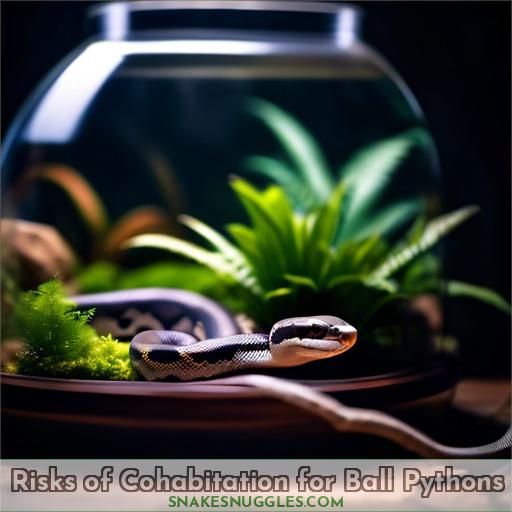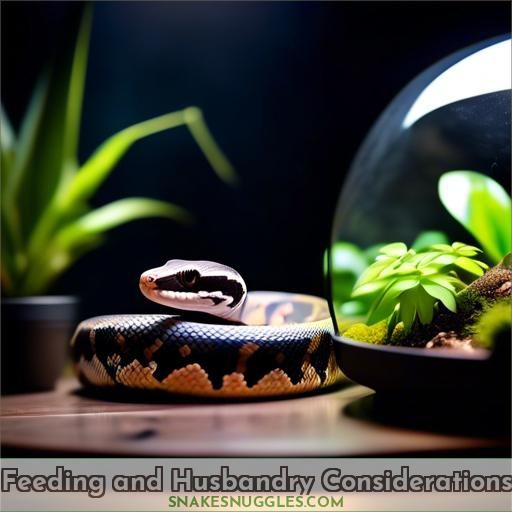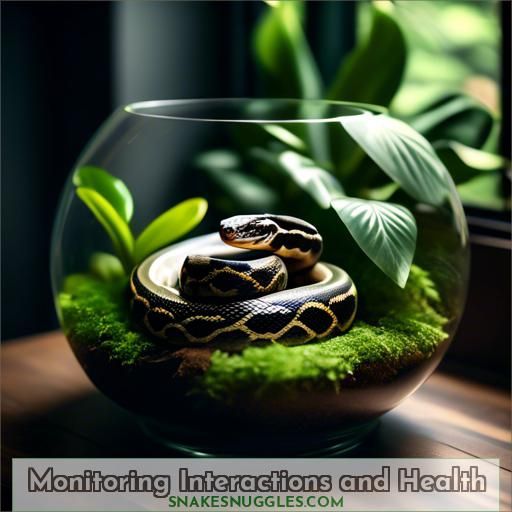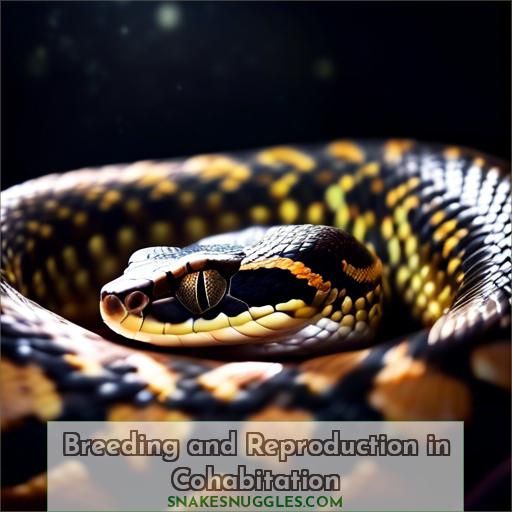This site is supported by our readers. We may earn a commission, at no cost to you, if you purchase through links.
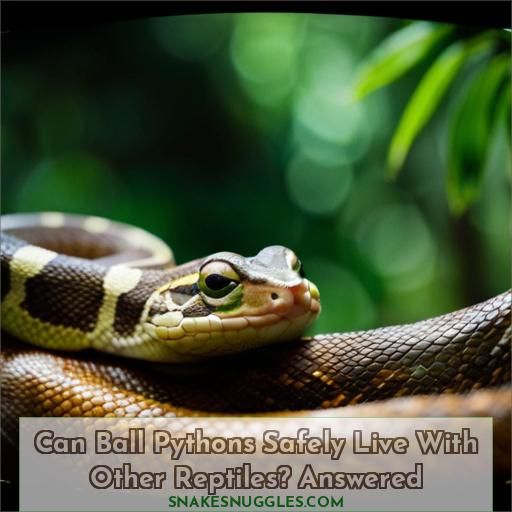
Ball pythons can coexist with other reptiles, but it is paramount to weigh the potential advantages and disadvantages. Cohabitation can offer ample space, enhance genetic diversity, and mitigate predation risk. However, it also presents challenges such as harm from dominance disputes, disease transmission, aggression, hygiene concerns, and competition for resources.
To safeguard well-being, select suitable species like turtles or tortoises, provide adequate space and designated enclosures, and vigilantly monitor interactions. Enclosure requirements include 3-4 feet of space per snake, separate enclosures, sufficient humidity and temperature, and a UV-A bulb for digestion and health.
Feeding and husbandry considerations include frequent veterinary consultations, cautious monitoring of temperature and humidity, and vigilance when feeding live prey. Cohabitation can also lead to breeding and reproduction, but potential complications should be addressed promptly.
Table Of Contents
- Key Takeaways
- Can Ball Pythons Live With Other Reptiles Answered?
- Benefits of Cohabitation for Ball Pythons
- Risks of Cohabitation for Ball Pythons
- Choosing Suitable Companions for Ball Pythons
- Enclosure Requirements for Cohabitation
- Feeding and Husbandry Considerations
- Monitoring Interactions and Health
- Breeding and Reproduction in Cohabitation
- Potential Problems and Solutions for Cohabitation
- Frequently Asked Questions (FAQs)
- Conclusion
Key Takeaways
- Ball pythons can coexist with other reptiles, but it is crucial to consider the potential advantages and disadvantages.
- Cohabitation can provide ample space, enhance genetic diversity, and mitigate predation risk, but it also presents challenges such as dominance disputes, disease transmission, aggression, hygiene concerns, and competition for resources.
- To ensure the well-being of ball pythons, select suitable species like turtles or tortoises, provide adequate space and designated enclosures, and vigilantly monitor interactions.
- Enclosure requirements include 3-4 feet of space per snake, separate enclosures, sufficient humidity and temperature, and a UVA bulb for digestion and health. Feeding and husbandry considerations include frequent veterinary consultations, cautious monitoring of temperature and humidity, and vigilance when feeding live prey.
Can Ball Pythons Live With Other Reptiles Answered?
Yes, ball pythons can live with other reptiles, but it’s essential to make sure that they’ve the necessary space and resources to coexist harmoniously. Ball pythons can share space with reptiles like tortoises and turtles, but they should have enough room to avoid feeling crowded or threatened.
However, housing ball pythons together can result in competition for resources, stress, and possible aggression, which can have a negative impact on their health and well-being. It’s generally advisable to keep ball pythons in separate enclosures to guarantee their safety and well-being.
Benefits of Cohabitation for Ball Pythons
Cohabitation can offer benefits for ball pythons, such as providing ample space and ensuring safety measures. Dietary considerations should also be taken into account when considering cohabitation.
Space Requirements
Ball pythons are known for their low-maintenance and docile nature, making them excellent pets for those who want a companion snake. When it comes to cohabitation, these snakes can benefit from sharing an enclosure with appropriate companions. Here are some considerations for space requirements when housing ball pythons together:
- Enclosure size: Ball pythons need a suitable habitat that provides enough space for them to move around comfortably. A general rule of thumb is to provide at least 24 square feet of space per ball python, ensuring that their enclosure is large enough to accommodate their habitat preferences and species compatibility.
- Space limitations: Ball pythons are relatively small snakes, but they still require ample space to live comfortably. When considering cohabitation, it’s important to make sure that the enclosure isn’t overcrowded, as this can lead to stress and potential conflicts between the snakes.
- Appropriate companions: Ball pythons can cohabit with certain reptiles, such as turtles and tortoises, but it’s recommended to provide separate enclosures for safety reasons. When choosing companions for ball pythons, it’s critical to think about their dietary needs, as well as their compatibility in terms of size and temperament. For example, ball pythons may not be suitable for cohabitation with other snakes, as they can exhibit aggressive behavior and may even attempt to eat smaller snakes.
- Habitat preferences: Ball pythons are native to regions with semi-arid grasslands, forests, and fields, so it’s important to provide an enclosure that mimics their natural habitat as closely as possible. This includes providing hiding spots, climbing branches, and appropriate temperature and humidity levels.
- Species compatibility: When cohabiting ball pythons with other reptiles or snakes, it’s important to consider their specific needs and behaviors. For example, ball pythons are known to be solitary animals in the wild, and they don’t typically breed in large groups.
Safety Measures
As a responsible pet owner, safety should always be your utmost priority when cohabiting ball pythons with other reptiles or animals. To safeguard the well-being of your pets, consider these safety measures:
- Monitor interactions closely: Keep a vigilant eye on your ball pythons when they’re together, especially during the initial weeks of cohabitation. This will help you identify any signs of aggression or stress that may indicate a need for separation.
- Veterinary consultations: If you notice any peculiar behavior or health issues, consult with a veterinarian experienced in reptile care. They can provide guidance on how to address any issues that may arise from cohabitation.
- Habitat modifications: Ensure that the enclosures are sufficiently spacious to accommodate all animals comfortably and provide ample hiding spaces. This will help mitigate stress and foster a sense of security for your pets.
- Feed ball pythons frozen mice: To minimize the risk of injury or disease transmission, it’s recommended to feed your ball pythons frozen mice rather than live prey. This will also help reduce the chances of aggressive behavior during feeding time.
- Separate enclosures: If feasible, maintain separate enclosures for each ball python. This will help avert conflicts and reduce the risk of disease transmission.
Dietary Considerations
Dietary Considerations for Cohabitation:
- Dietary Restrictions: Ball pythons only eat mammals and rodents, so they can’t live with reptiles that require different prey.
- Feeding Schedules: Maintaining consistent feeding schedules is paramount for the health of your ball python and potential companions.
- Meal Frequency: Guarantee that the ball python isn’t overfed or underfed, as this can lead to health issues.
- Prey Size and Type: Choose the right prey size for your ball python and avoid feeding it live prey, as this can lead to injury or death.
Risks of Cohabitation for Ball Pythons
Cohabitation with another snake can pose significant risks to your Ball Python. These risks include injury, disease transmission, aggression, hygiene issues, and competition for resources. Injury can occur when two snakes compete for dominance, leading to stress-related illnesses or physical harm. Disease transmission is a concern, as snakes can carry pathogens that can be spread to other snakes in the same enclosure. Aggression can also be a problem, as snakes may become stressed or territorial when living with another snake. Hygiene issues can arise when multiple animals share the same enclosure, potentially leading to infections. Finally, competition for resources can result in malnutrition and poor health for your Ball Python.
To reduce these risks, it’s essential to provide adequate space, prevent prolonged hunger, feed your Ball Python frozen mice, and observe interactions carefully. It’s typically advisable to keep Ball Pythons in separate enclosures for safety and well-being.
Choosing Suitable Companions for Ball Pythons
Yes, ball pythons can coexist with certain reptiles, such as turtles and tortoises, provided they’ve the space they need. However, it’s recommended to keep them in separate enclosures for safety and to avoid competition for resources.
Ball python companions
When considering ball python companions, essential benefits, species compatibility, and enclosure planning are critical factors. Here’s a list of considerations:
- Species compatibility: Choose species that are compatible with ball pythons, such as certain turtles and tortoises.
- Enclosure design: Guarantee adequate space and separate enclosures for safety.
- Feeding strategies: Provide ample space and feed ball pythons frozen mice to avoid extended hunger.
- Health risks: Monitor interactions attentively and avoid cohabitation with other snakes, as ball pythons don’t eat them.
Choosing reptiles
When choosing reptiles for cohabitation with ball pythons, compatibility issues are paramount. Consider personality types, habitat requirements, and resource distribution. Enrichment activities should be offered for both species to guarantee their well-being. Remember, safety is of utmost importance, so always prioritize their welfare.
Safe cohabitation
To maintain secure coexistence for ball pythons, adhere to these guidelines:
- Select the safest reptiles: Turtles and tortoises can coexist, but separate enclosures are advised for safety.
- Ample space: Offer sufficient room for all animals to move comfortably.
- Frozen prey: Accustom ball pythons to frozen mice to reduce aggression.
- Feeding schedule: Maintain a consistent feeding schedule to avoid extended hunger.
- Hydration needs: Guarantee all animals have access to clean water.
Enclosure Requirements for Cohabitation
When thinking about cohabitation for your ball python, enclosure needs are very important to make sure that both your snake and its friend are safe and doing well. Here are three main things to think about:
- Space Needs: Both snakes need enough room to move around and not fight. A good rule is to give at least 3-4 feet of space per snake, depending on how big they’re and how active they are.
- Safety Measures: For safety, it’s best to have separate enclosures, especially when cohabiting with a different kind of snake. This helps keep them from getting hurt and makes it less likely that they’ll get sick from each other.
- Dietary Considerations: Make sure that the enclosure is big enough for how often you feed them and how humid it needs to be. For example, if you feed your ball python live prey, make sure the enclosure is big enough for the prey without making the snake feel stressed or uncomfortable.
Feeding and Husbandry Considerations
When considering cohabitation for ball pythons, feeding and husbandry practices play a critical role in safeguarding the safety and well-being of both species. It’s imperative to maintain specific temperature gradients and humidity levels within the enclosure to recreate the natural habitat of the ball python.
In terms of feeding, it’s advisable to provide live prey at 10% of the snake’s weight weekly. Ball pythons typically consume mammals and rodents, but it’s essential to train them on frozen mice to avoid the risks associated with live prey. These risks include the potential for disease transmission, stress to the snake, and even injury or death.
To ensure the safety of both species, it’s also crucial to monitor the feeding practices and husbandry routines of the companion species. This includes providing sufficient space and avoiding prolonged hunger, which can lead to aggressive behavior or health issues.
Incorporating a UV-A bulb in the basking spot can also be beneficial, as it aids in digestion and overall health.
| Feeding Practices | Husbandry Routines |
|---|---|
| Live prey at 10% of the snake’s weight weekly | Maintain specific temperature gradients and humidity levels |
| Train ball pythons on frozen mice | Provide sufficient space and avoid prolonged hunger |
| Incorporate a UV-A bulb in the basking spot | Monitor the feeding practices and husbandry routines of the companion species |
Monitoring Interactions and Health
As a conscientious pet owner, it’s paramount to vigilantly observe your ball python’s interactions and general health. Here are four key aspects to ponder upon:
- Veterinary consultation: Regular veterinary appointments are imperative for safeguarding your ball python’s well-being. A professional can assist in detecting any health concerns and administering suitable treatment.
- Differential diagnoses: Should your snake’s condition remain enigmatic, a veterinarian can conduct diverse tests to eliminate potential ailments, such as cardiac disease or an abscess.
- Husbandry parameters: Monitor your ball python’s environment, ensuring the temperature and humidity levels are suitable for its species. This encompasses maintaining a temperature gradient within the enclosure and providing an adequate heat source.
- Live prey: Exercise caution when feeding your ball python live prey, as it can occasionally cause injury or stress. Consistently use pre-slaughtered or frozen mice, and ensure they’re no larger than the widest part of your snake.
Breeding and Reproduction in Cohabitation
Breeding advantages are abundant when cohabiting ball pythons. They can increase genetic diversity, leading to healthier offspring. However, reproduction challenges can arise. One of the main challenges is ensuring the safety of the hatchlings, as they’re vulnerable to predation.
To maximize offspring survival, it’s essential to provide suitable enclosures and carefully monitor the interactions between the adults. A 2×2 table can help illustrate the importance of these factors:
| Factor | Advantages | Challenges |
|---|---|---|
| Genetic Diversity | Increases health and resilience of offspring | Difficult to achieve in small groups |
| Hatchling Care | Reduces predation risk | Requires constant monitoring |
| Enclosure Size | Provides ample space for all animals | Can be expensive and difficult to maintain |
| Interaction Monitoring | Helps prevent aggression and injury | Time-consuming and requires expertise |
Potential Problems and Solutions for Cohabitation
When considering cohabitation for ball pythons, it’s fundamental to be aware of the potential risks and challenges. Here are four common issues and their solutions:
- Dominance Competition: Ball pythons can become aggressive and assert dominance over other snakes, which can lead to stress and injury for the submissive snake.
- Solution: Make sure the enclosure is large enough to provide ample space for each snake to establish its territory and avoid direct confrontation.
- Food Competition: More aggressive ball pythons may take food from their less confident counterparts, leading to malnutrition and poor health.
- Solution: Feed each snake separately to avoid competition and ensure they receive adequate nutrition.
- Stress and Anorexia: Stress can cause ball pythons to stop eating, which can lead to serious health issues.
- Solution: Monitor the snakes closely for signs of stress and separate them if necessary to reduce stress levels.
- Cannibalism: While rare, ball pythons can exhibit cannibalistic behavior, especially when one snake is noticeably larger than the other.
- Solution: House snakes of similar sizes to minimize the risk of cannibalism.
In addition to these challenges, it’s critical to provide sufficient space, avoid prolonged hunger, and feed ball pythons frozen mice to maintain their health and well-being. Always remember that ball pythons are solitary animals and prefer their own space, so cohabitation should be approached with caution and careful monitoring.
Frequently Asked Questions (FAQs)
Can ball pythons live with other reptiles?
No, ball pythons shouldn’t live with other reptiles. They’re solitary animals and don’t appreciate the company of other reptiles. Cohabitation can lead to stress, dominance competition for resources, and even cannibalism. It’s recommended to keep ball pythons in separate enclosures for their safety and well-being.
What are the benefits of cohabitation for ball pythons?
Cohabitation of ball pythons can have several benefits, such as:
- Reduced stress: Sharing an enclosure with another snake can provide a sense of security and companionship, which can help reduce stress levels in both snakes.
- Improved socialization: Ball pythons aren’t strictly solitary animals, and they can develop social bonds with other snakes, especially during mating season.
- Increased exercise: Sharing an enclosure can encourage more activity and exploration, as snakes may compete for resources like basking spots or hides.
- Enhanced enrichment: Providing multiple hides and basking spots can create a more stimulating environment for the snakes.
However, it’s vital to take into account the potential risks and challenges associated with cohabitation, such as:
- Dominance competition: Ball pythons may assert dominance over each other, leading to stress-related illnesses or physical injury.
- Resource competition: Snakes may compete for resources like basking spots or hides, which can cause stress and potentially lead to aggression.
- Cannibalism: Ball pythons have been known to exhibit cannibalistic behavior when housed together, especially during high-stress situations or in improper setups.
- Disease transmission: Co-habiting ball pythons can increase the risk of disease transmission, especially if the snakes aren’t properly quarantined before being housed together.
To guarantee a successful cohabitation experience, it’s essential to provide ample space, resources, and separate enclosures for each snake. It’s also recommended to monitor interactions closely and separate the snakes if aggression or stress becomes apparent.
How can I choose suitable companions for my ball python?
To select appropriate companions for your ball python, consider the following:
- Size: Make sure the companion species aren’t significantly larger than your ball python, as they may frighten or injure your pet.
- Temperament: Choose species with a gentle and relaxed temperament, as this will decrease the likelihood of aggression.
- Diet: Verify that the companion species have a comparable diet to your ball python, as this will reduce competition for food.
- Behavior: Select species that are active during the same hours as your ball python, as this will minimize the potential for one species disturbing the other.
- Cohabitation: Ball pythons are generally solitary animals, so it’s advisable to keep them separated unless you have significant experience with both species and a spacious enclosure.
What are the enclosure requirements for cohabitation?
To cohabit ball pythons with other reptiles, you should provide ample space and avoid prolonged hunger. Enclosure requirements include a minimum of 8 square feet of floor area and at least 2 feet of vertical space for climbing, with dimensions based on the snake’s length.
Ball pythons can coexist with certain reptiles, such as turtles and tortoises, but cohabitation with other snakes is challenging and requires constant supervision due to the risk of accidental bites and defense mechanisms.
It is recommended to feed ball pythons frozen mice. Separate enclosures are recommended for safety when cohabiting ball pythons with other reptiles, as close monitoring of interactions is necessary.
How can I monitor interactions and health between ball pythons?
To monitor interactions and health between ball pythons, you can follow these steps:
- Observe their posture and behavior: A healthy ball python usually lies in a flat coil. Abnormalities like stargazing (elevated head position) can signal respiratory infections.
- Check for signs of illness: Look for symptoms like wheezing, labored breathing, mucus bubbles, digestive issues, or anorexia.
- Maintain a clean enclosure: Regularly change water and substrate to prevent respiratory infections or scale rot.
- Handle with care: Avoid handling after feeding or when the snake is stressed.
- Monitor feeding habits: Make sure the snake is eating regularly and defecating properly.
- Provide enrichment: Hides, foliage, and other enrichment can help prevent aggression and stress.
- Keep the environment safe: Remove potential threats from the snake’s enclosure.
- Seek veterinary attention: If you notice any unusual behavior or health concerns, consult a herp vet for proper diagnosis and treatment.
Conclusion
Yes, ball pythons can live with other reptiles, but it requires careful consideration. Cohabitation offers advantages like shared space and security, but also poses risks such as disease transmission and aggression between species.
Selecting appropriate companion animals and providing suitable enclosures is imperative when considering cohabitation. Ball pythons can coexist with other reptiles, but it is essential to weigh the advantages and disadvantages thoroughly before making this decision.


